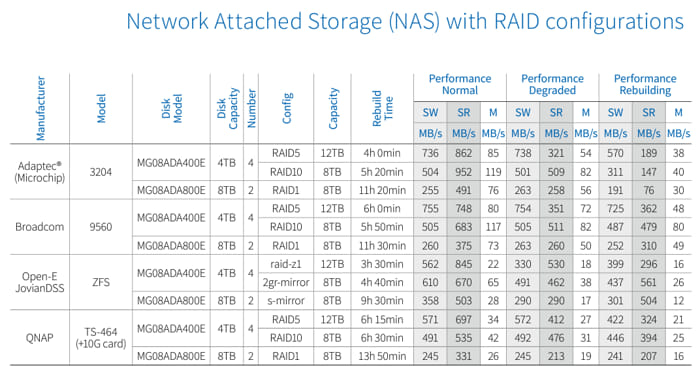Evaluating RAID Systems Based on NAS
Lab tests at Toshiba indicate best ways to configure NAS for maximum results.
This is a Press Release edited by StorageNewsletter.com on March 22, 2024 at 2:02 pm By Rainer W. Kaese, senior manager, HDD business development, Toshiba Electronics Europe GmbH
By Rainer W. Kaese, senior manager, HDD business development, Toshiba Electronics Europe GmbH
RAIDs gained popularity over a quarter of a century ago, formalising the market for secure and reliable enterprise storage systems that provide shared access to data. Companies, small businesses and even private individuals use them because, compared to using a single HDD, a RAID can protect valuable data from storage media failures, improve performance, and increase resiliency.
Just as different configurations of RAID can be more or less suitable for any give storage application, there are different ways to configure NAS, and the configurations behave differently in different circumstances. Understanding the subtle differences will be instructive when deciding which configuration to adopt.
RAID variations
RAIDs are traditionally defined as a set of storage assets installed in one system, but treated logically as a single storage device. An important characteristic is enterprise availability, meaning that a RAID remains up, running, and accessible to qualified network users for all but a few minutes every year. The data is protected by either mirroring it, or using a parity scheme where lost data can be recovered by recalculating it from the still existing information.
There are many ways to configure a RAID, and each carries a different numerical designation, from RAID-0 to RAID-60. For example, RAID-0 stripes data (distributes blocks of data across multiple drives), but with no mirroring (creating a complete copy of a data set) and no parity (dedicating a drive for fault tolerance). As a practical matter there is no redundancy in this configuration; data can be lost if any part of the system fails.
RAID-1, meanwhile, has no striping or parity, but blocks are mirrored. In RAID-5, blocks are striped, and there is distributed parity. RAID-10 is characterized by blocks that are striped and mirrored. Where RAID-0, RAID-1 can be configured with only 2 drives, RAID-5 depends on at least 3, while RAID-10 is commonly deployed starting with 4 but ranging to any higher even number.
NAS
NAS systems consist of a RAID storage subsystem connected to the network. They can be equipped with a variable number of storage devices.
The storage devices are commonly HDDs, though SSDs are sometimes used. Desktop-style NAS equipped with 2 HDDs are sufficient for many uses, but configurations with 4 drives are not uncommon, and some will hold up to 8. Enterprise systems, often set up in a rackmount form-factor, can have 12, 16 or even up to 24 HDDs.
NAS data
Which gives rise to the question: how do various RAID configurations perform with different NAS set-ups? For our RAID level evaluation we focus on the popular 2 and 4 bay entry models.
The Toshiba HDD Laboratory tested several NAS systems from several manufacturers, each expanded with a 10GbE network card to avoid performance bottlenecks in the network connectivity. We tested each NAS with both 2 and 4 Toshiba Model MG08ADA400E Enterprise 4TB HDDs.
We stored 6TB of data in the system and measured performance for 1) sequential writing of 1MB blocks, 2) sequential reading of 1MB blocks and a random reading, and 3) mixed read- and write workload of a mix of different block sizes.
We also tested configurations using either hardware RAID controllers or software RAID control. For 2 or 4 drives, hardware RAID is the most common and appropriate way to manage. But with performance and cost-efficient compute power (CPU, DRAM etc.) RAIDs can also be managed entirely by software, with the advantage of offering additional storage features such as snapshots, backups and more.
The 2 hardware RAID controllers tested were among the most popular in the market for systems with up to 8 drives: the Broadcom MegaRAID 9560-8i and the Adaptec SmartRAID-3204-8i from Microchip. For SDS we tested the Zettabyte File System (ZFS) managed by Open-E JovianDSS software.
Table 1: Measurement results for Qnap NAS (SW = SeqWrite, SR = SeqRead, M = Mixed)

The sequential performance values for NAS with RAID configurations are insignificantly lower than for the hardware RAID controllers, while the random performance is similar to ZFS without caching.
Comparing RAID-5 and RAID-10, RAID-5 is about 20 % faster in terms of sequential speed and RAID-10 is 20% faster with a view to random/mixed workloads.
Most NAS systems still come with either a 1GbE or 2.5GbE interface, so it needs to be emphasized that the sequential performance values of 200MB/s and larger require a 10GbE interface at minimum. Using a 1GbE interface limits the sequential speed to about 100MB/s, which is lower than a single HDD. Using a 2.5GbE increases the maximum speed to 250MB/s which is enough for a 2-Bay RAID-1 configuration. Only with 10GbE can we achieve speeds beyond that level.
So, any tradeoff / optimization in terms of sequential speed is only relevant for 10GbE or higher speed networks. For 1GbE and 2.5GbE network infrastructures, 2 HDDs in RAID-1 are enough. Just for workloads with many random read/write accesses, 4 drives of RAID-10 may bring a speed advantage of about 1.5x.
Summary
Storage administrators have to take into consideration a number of factors when evaluating network storage configurations, whether it is a RAID configuration in general or NAS configuration specifically.
They include:
- How much capacity do I need?
- What is my typical workload?
- Are there any limitations imposed by the host/network connectivity?
After testing, our recommendation for RAID setups in NAS is:
- RAID-1 (plain mirroring) of 2 drives of higher capacity is the configuration of choice for reasonable economic NAS systems in homes and small businesses with network connectivity at 1GbE or 2.5GbE.
- RAID-5 (parity protection) of 4 drives is best for all kinds of storage system solutions where the majority of the workload has a sequential nature. It also provides the best storage efficiency (75%). It is therefore suitable for high net capacity requirements and delivers the shortest possible rebuild times for failing drive replacements.
- Raid-10 (striping and mirroring) of 4 drives: this is best for random/mixed workloads, of course trading off at a lower storage efficiency of only 50%. RAID-10 is recommended for local server storage subsystems for generic workloads using hardware RAID controllers or software RAID technology.














 Subscribe to our free daily newsletter
Subscribe to our free daily newsletter


